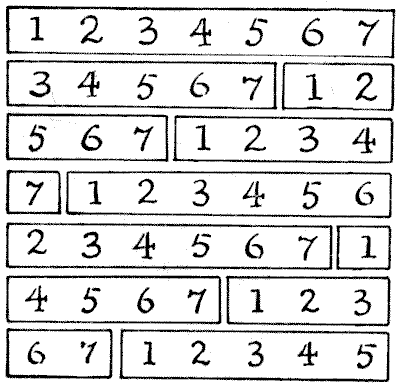(related to Problem: The Magic Strips)
There are of course six different places between the seven figures in which a cut may be made, and the secret lies in keeping one strip intact and cutting each of the other six in a different place. After the cuts have been made there are a large number of ways in which the thirteen pieces may be placed together so as to form a magic square. Here is one of them:—

The arrangement has some rather interesting features. It will be seen that the uncut strip is at the top, but it will be found that if the bottom row of figures be placed at the top the numbers will still form a magic square, and that every successive removal from the bottom to the top (carrying the uncut strip stage by stage to the bottom) will produce the same result. If we imagine the numbers to be on seven complete perpendicular strips, it will be found that these columns could also be moved in succession from left to right or from right to left, each time producing a magic square.
This eBook is for the use of anyone anywhere in the United States and most other parts of the world at no cost and with almost no restrictions whatsoever. You may copy it, give it away or re-use it under the terms of the Project Gutenberg License included with this edition or online at http://www.gutenberg.org. If you are not located in the United States, you'll have to check the laws of the country where you are located before using this ebook.